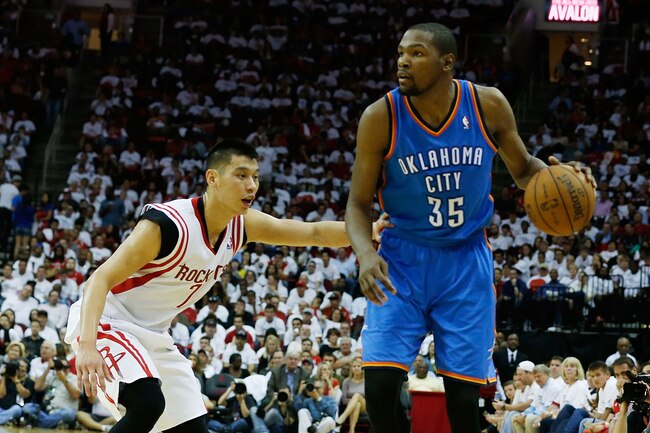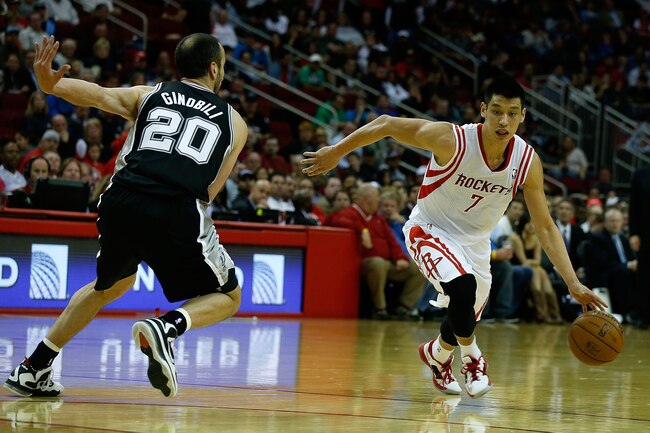Can Houston Rockets Win a Title with Jeremy Lin as Starting Point Guard?
By on September 18, 2013
 Scott Halleran/Getty Images
Scott Halleran/Getty Images In his first season with the Houston Rockets, Jeremy Lin was an unpredictable player.
Once cloaked in a cloud of charmed play—carrying back to those transcendent days of “Linsanity” while playing for the New York Knicks—Lin’s tenure in Houston commenced in a haze of frustration.
Offseason knee surgery set Lin’s season off to a rocky start, and it eventually led to his playing time being usurped by backups like Toney Douglas and Patrick Beverley; both felt like safer fourth quarter options, particularly on the defensive end.
Now, heading into his second year as Houston’s starting point guard, the Rockets are faced with loftier team expectations, on par with any other legitimate championship contender.
Dwight Howard is the starting center, and James Harden is looking to improve upon his own first-year experience with the team (a sublime breakout season in which he made his first All-Star game).
Two superstars are on board, and Lin is still steering the ship. In fact, his overall performance last season was actually on par with, if not better than, most young point guards going through their first season as a full-time starter.
Can he handle it, or should this be a cause for concern?
 Scott Halleran/Getty Images
Scott Halleran/Getty Images
Lin appeared in all of Houston’s 82 regular season games last year, averaging 13.4 points and 6.1 assists.
His campaign was marred with inconsistent play, but in it were pocket stretches of expertise. On December 10 he scored 38 points against the San Antonio Spurs, making all 12 of his free-throw attempts and finishing the night 11-of-21 from the floor (going along with seven assists, two steals and two blocks).
Less than two months later, Lin recorded nine assists and scored 28 points in just 32 minutes in a 31-point victory against the Golden State Warriors. He throttled the Knicks in Madison Square Garden one week before Christmas, and on two separate occasions he sliced through the stingy defenses that reside in Chicago and Memphis with double-digit assist performances.
(Also: the Rockets went 9-2 in the 11 games when Lin used at least 26 percent of his team’s possessions, according to Basketball-Reference.com.)
According to SynergySports, just over one out of every four possessions Lin ended with a turnover, field goal attempt or drawn foul came after he initiated a pick-and-roll. When it comes to scoring, this is where Lin’s most comfortable; it’s his bread-and-butter, and where he shows the most confidence and aggression. (Lin shot just under 50 percent from the floor as the ball-handler on pick-and-rolls last season.)
Here are two clips that show Lin receiving a screen, reading how the defense is playing the pick-and-roll then aggressively setting out to pummel the basket.
He was better finishing at the rim than John Wall, Kyrie Irving, Russell Westbrook and Rajon Rondo last year, converting 62.4 percent of his shots on 4.0 attempts per game—a sizable figure relative to every other point guard in the league, per Hoopdata.
At times, he can be very effective pressuring the defense and making them work. But while it’s silly to chalk Lin’s first year with Houston up as a colossal disappointment, it’s equally inane to ignore his struggles altogether.
Here’s a closer look at some areas where Lin needs to improve if Houston is going to realistically compete for a championship this season.
Lin Needs To Limit Turnovers
Once he receives a screen, Lin loves maneuvering into the paint for a shot. (He's even developed a pretty floater that's as difficult as it is aesthetically breathtaking.) This mindset exists as a dual-edged sword for him though; Lin tends to dribble himself into trouble whenever defenses bring the roll defender up to double him, panicking unnecessarily and either throwing the ball away or forcing a bad pass well after the defense has properly rotated.
This season, he needs to do a better job of recognizing the varying coverage teams will throw in his direction when he receives a high screen.
When it calls for him to attack, Lin doesn't hesitate to do so, which is fantastic. But when the defense is telling him to get the ball out of his hands, he needs to do it much quicker than before.
Tightening Up His Pick-and-Roll Defense
Cutting down on turnovers is an obvious objective every player in the league should personally be cognizant of. But for Lin, the starting point guard on a team with potential to have one of the five most efficient offenses in the league, protecting the ball is priority number one.
Another area of Lin's game that came under scrutiny last season was his defense.
Overall he isn't as poor on this side of the ball as has been let on. He moves well laterally, has quick hands and sound instincts on the ball.
But against the pick-and-roll he really struggled. And that's something a guard possessing his athleticism should be able to clean up just a bit.
Below are two pictures taken moments after Lin is hit with a high screen. Instead of fighting over it and sticking as close to his man as possible, he falls two or three steps behind, allowing five-on-four advantages and wide open jumpers for guys who happily eat those opportunities for breakfast.


Increasing Comfort Level At The Three-Point Line
Defending the pick-and-roll is a difficult, tiring exercise for any point guard, especially one who's also tasked with running a high-tempo offense. The steps for improvement here are minor, but crucial. And Lin should be more than capable of getting them done—especially if Houston's offense becomes more centered in the half-court with Howard on the court.
Speaking of Howard, making his life easier should be another one of Lin's priorities this season. The team's new center is one of the league's best players, and one way to help him succeed is by providing him with room to operate in the post.
How can Lin do that? Force defenses to respect his three-point shot.
Lin was slightly better than his career average on three-pointers last season, making 33.9 percent of 3.1 attempts per game. On a Houston Rockets team that should be maniacally obsessed with the three-point line next season, Lin’s ability to knock this down regularly (he was nearly equally accurate from the corner as he was above the break, according to NBA.com/Stats) will go a long way helping Houston spread the floor. As was previously mentioned, this helps Howard breathe in the post, but it also gives Harden more space to create killer pick-and-roll action, and opens up driving lanes for him and Parsons.
There were some hopeful flashes with Lin’s shot towards the end of last season. He made 42.4 percent of his threes in February (11 games) and 40.0 percent in March (14 games).
He doesn’t need to stroke the deep ball at an insane Steph Curry/Mike Conley-like rate (though it’d be nice), but bumping his average a few percentage points above league average (36.0 percent last season among point guards, according to Hoopdata) would be extremely beneficial.
 Scott Halleran/Getty Images
Scott Halleran/Getty Images
The Houston Rockets have finally built a roster that—on paper—looks strong enough to battle for a title.
They'll only go as far as Harden and Howard are capable of leading them, but Lin still stands as an integral component, and if he struggles improving in the areas listed above, Houston probably won't have enough firepower to smash through the Western Conference's house of horrors.
Lucky for them—and thanks to his restored health and pressure-reduced role—Lin is more than capable of improving.
 選擇“Disable on www.wenxuecity.com”
選擇“Disable on www.wenxuecity.com”
 選擇“don't run on pages on this domain”
選擇“don't run on pages on this domain”

